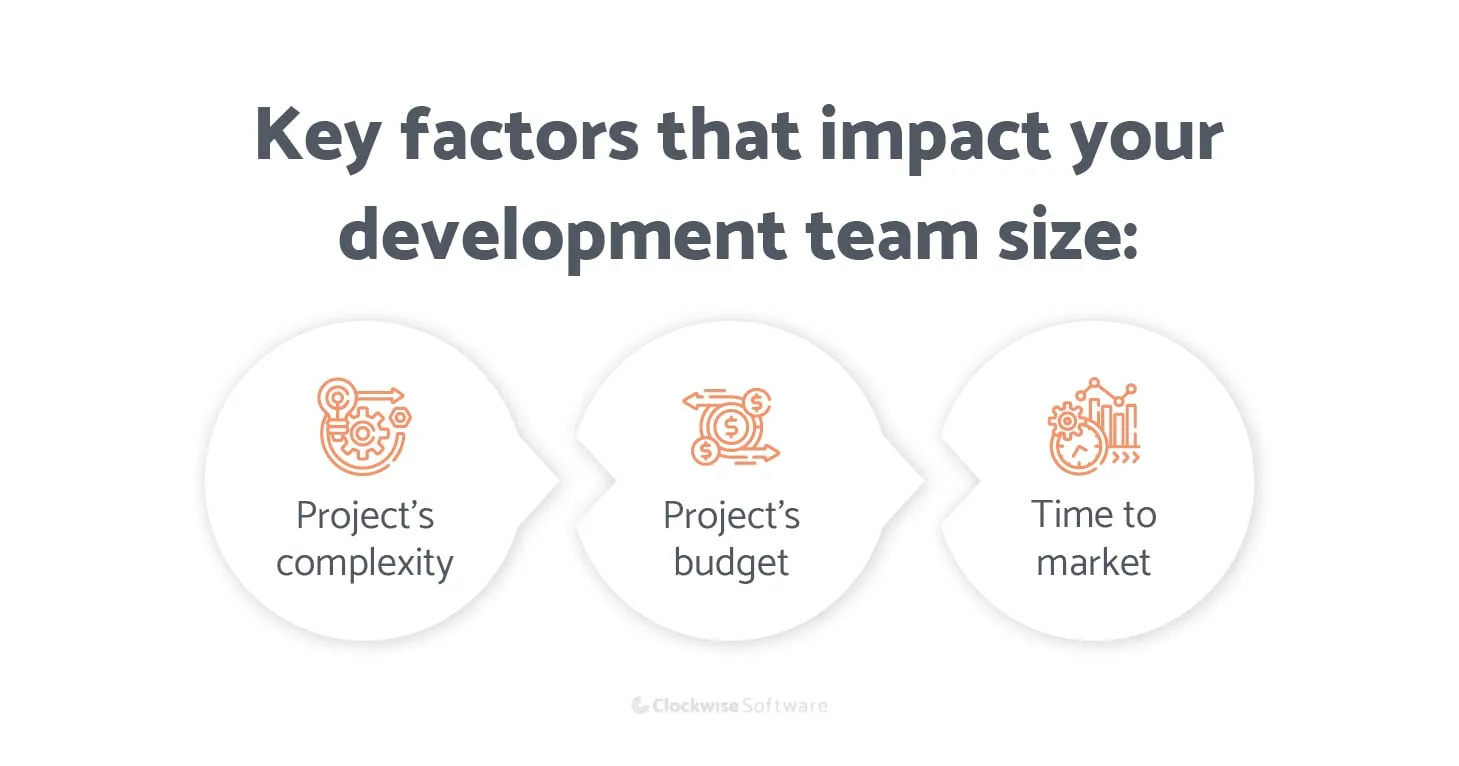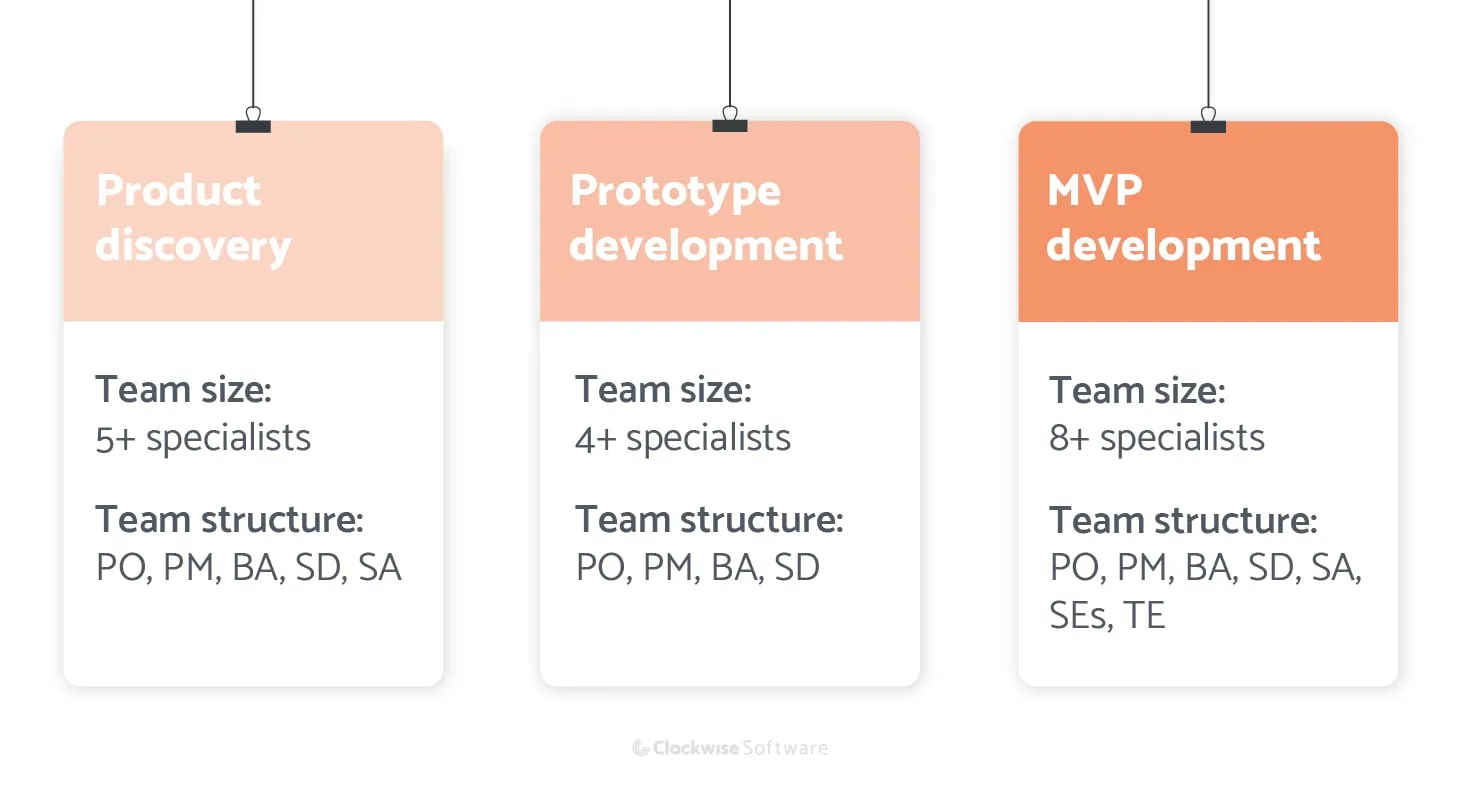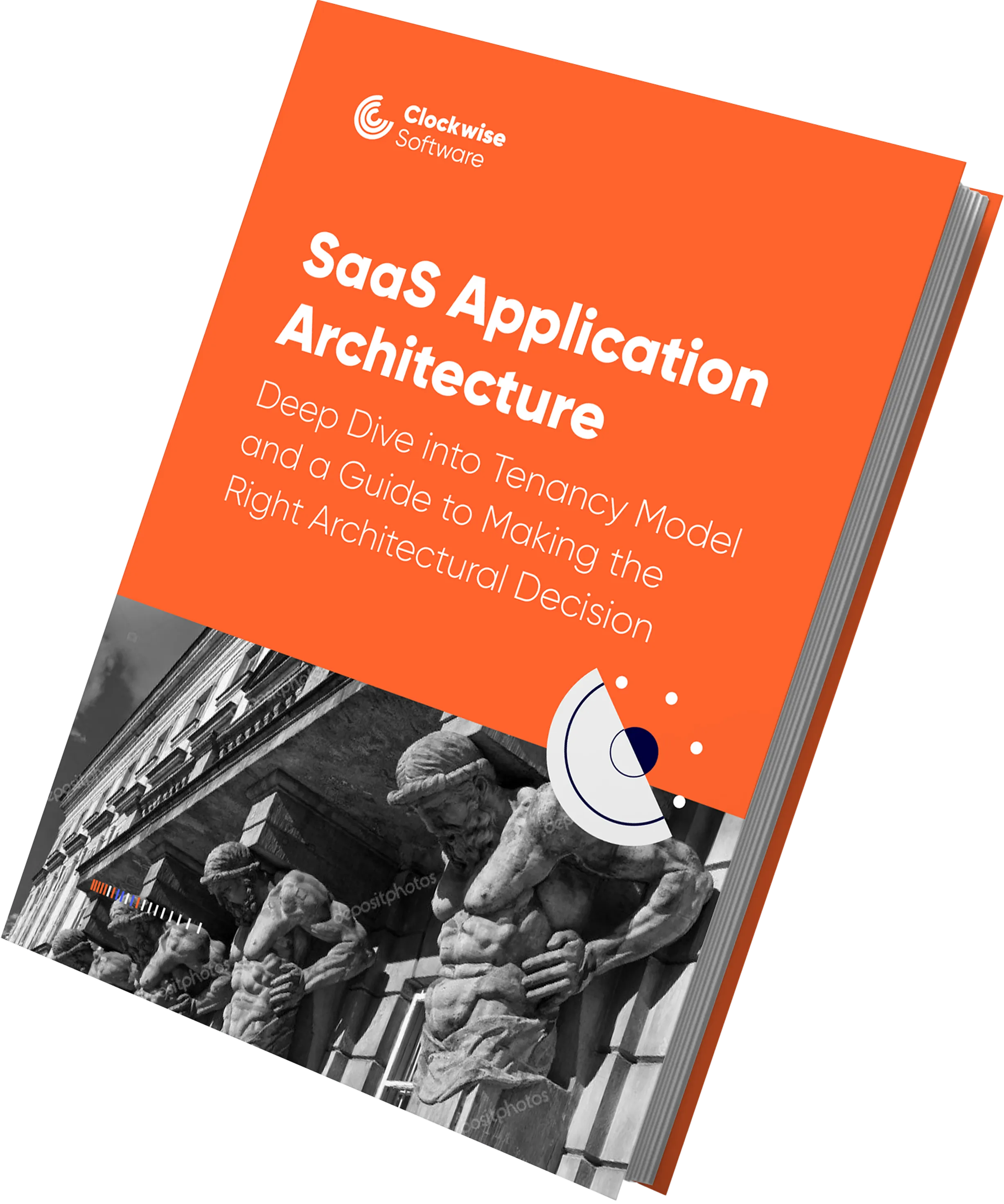Software Development Team Structure: Approaches, Roles & Factors to Consider
Summarize:
Key takeaways
- The software development team typically consists of such specialists: product owner (PO), project manager (PM), business analyst (BA), software designer, software engineers, and QA specialists.
- The size of the software development team is identified by such key factors as the project’s idea, complexity, budget, business requirements, and expected time to market.
- The software development team structure depends on the project’s goals and startup phases: for product discovery, you will need 5+ specialists; for prototype development — 4+, while MVP development will require a team of 8+ specialists.
You’re about to build your next product. Your product vision is getting more detailed every day, and it’s time to turn it into a real product people look forward to using.
At this point, you may decide to delegate software engineering to an experienced partner who has a deep technology background.
But while it may seem at first glance that software engineers are the only specialists you need in your team composition, you’ll quickly learn that any software development team consists of different roles. Each specialist is responsible for particular business or technical tasks.
Who are all these people?
Why do you need to pay for their efforts?
How should you build your software development organizational structure?
And do you REALLY need them on your software development team?
Today, you’re going to get acquainted with the key roles of a software development team and find out how big your team should be to deliver a product of exceptional quality, and on which factors the software development team structure will depend.
Key roles in a software development team
Marty Cagan, a Silicon Valley-based project management guru, emphasizes the importance of the software development team in his book Inspired: How to Create Products Customers Love.
“
Every product begins with the people on the cross-functional product team. How you define the roles, and the people you select to staff the team, will very likely prove to be a determining factor in its success or failure.

Experienced software development team with wide yet deep expertise in digital product development lays the foundation for a product’s success. Team members dedicate their time, effort, and knowledge to your product’s growth. From the product discovery phase to a successful product launch, maintenance, and further growth, a development team contributes to every single stage of your product’s lifecycle. Thus, it’s critical to know who you should hire.
In this section, you’ll meet six key software development roles. You’ll find out their responsibilities as well as how they can optimize the work and save you costs at the early stages of product development.
Product owner (PO)
Let’s start with your role in your product development team structure.
As a product owner, you may participate in the project discovery and development processes to provide all product details to the development team. You may also delegate this role to someone with a clear vision of your idea who’s able to represent your interests, wishes, and app requirements.
A product owner, or PO, defines the product’s goal and explains it to the team. They communicate actively with all specialists involved in the development process and can answer any product-related questions. The product owner does not necessarily need to have a technical background.
If you’re new to app development, don’t worry: you can still play this role on your software engineering team. In such a scenario, many product owners often choose to take advantages of software outsourcing, delegating the development process to an experienced team, and only playing the role of a key decision-maker.
The product owner creates a product backlog — a list of requirements to be met at various stages of product growth. Items in a product backlog are the features you want to implement in your app. The product owner has to make sure the product backlog is transparent, detailed, and explicit.
Although the product owner communicates closely with the rest of the development team, they aren’t responsible for how (and whether) the software development team meets the project objectives. There’s another role for that.
The PO is a guiding light for the development team. If there’s no one to provide directions and clarify expectations, it’s likely the product will fail to meet business objectives and your expectations.
Project manager (PM)
A project manager (PM) in the development department structure is the one responsible for every step the software development team takes to meet your requirements and deliver the expected results. The project manager is solely responsible for the efficiency of product development and for optimizing the development process. It’s hard to overestimate the role of the PM in the app development process.
With proper project management, combined development efforts, thousands of lines of code, and a solid business idea, you can create a product that’s able to amaze, serve, and stand out for years.
Later, we’ll pay attention to the size of your team. But any project needs a project manager, no matter if it consists of two or 200 specialists.
The only exception is if you’re the only person working on a project. In this case, you don’t need a team or a project manager. However, successful commercial projects are not usually born this way. Even if you start all by yourself, soon you’ll still need a team to work on your project. If you don’t scale your team, your product won’t scale either.
A project manager closely communicates with the PO and possesses the necessary information about:
- Your business
- Your app’s users
- Your target market
Basic technical awareness makes a project manager an even more important member of the team. A qualified PM not only can ensure your product meets the requirements and satisfies stakeholders but can participate in estimating tasks, suggesting ways to improve the product, and providing a better understanding of the app to the software development team.
Poor project management may result in numerous consequences, including:
- Missing deadlines
- Exceeding the app’s budget
- Project failure
Business analyst (BA)
Life at Google is a thrilling YouTube channel packed with great videos about Googlers and insights from one of the most powerful IT corporations in the world. Check out this channel for an explanation of what business analysts do.
“
Business analysts analyze data to find different insights that will drive a business impact.
What if you don’t have a business yet? In this case, business analysts collect and analyze data, interpret the results, and come up with suggestions to launch a potentially popular app.
“
There are just a million questions you have to ask before you launch and after you launch. What are we trying to make happen? How can we prove that quantitatively? And are we confident in that?
These are questions a business analyst can answer. They bridge existing demands, pain points, and troubles with a real solution embodied in your software application. Business analysts work with tons of data to suggest the best ways to develop and improve your app. They also study competitors, define their weaknesses, and reveal users’ concerns to help you launch a better, more user-oriented app. For example, if you are working on a SaaS app, a business analyst within your SaaS software development team is the one to identify the high-growth SaaS companies in your industry and develop a strategy for capturing market share.
If you don’t have a business analyst on your team, your project may fail to meet users’ demands.
Without a BA on your team, you risk several unwanted outcomes:
- Users don’t want to use your product
- Users don’t like your product
- Users don’t need your product
Business analyst vs system analyst
It may be confusing to differentiate between the roles of business analyst and system analyst (SA), especially if you’re new to product development. Business analysis is a wider concept, covering an entire organization or business domain. System analysis focuses on technical specifics or the development of a particular product.
- A BA develops business requirements, while an SA interprets these requirements for the software system.
- A BA identifies the existing problem and describes what solution to implement. An SA reviews the project objectives and states how to implement the solution in an app.
- System analysis is an area of business analysis. Thus, in many teams, a business analyst plays the role of a system analyst.
Note: Business analysis is critical for decision-making when launching your startup. A business analyst may help you choose a potentially profitable niche, define steps to launch your business, or pivot if needed. A project manager skilled in market research and analysis may play the role of a business analyst. However, if a project manager has never worked with similar tasks, this may be inefficient. Consider hiring a separate business analyst or outsourcing business analysis to a dependable partner.
UI/UX designer or software designer (SD)
According to Zippia’s research, better UX design may cause a 200% jump in your conversion rate. 70% of online businesses fail due to bad useability.
This is why you need a skilled UI/UX designer on your software development team.
There’s a misconception that software engineers can design an app. Engineers may indeed use a ready-made template. But in this case, your app will look exactly like thousands of other apps. Besides, your idea isn’t built for a specific template. Trying to make it fit into one may result in an app that looks cheap and unattractive.
The primary task of bespoke software developers is to code, not to create nice designs. UI/UX design requires creativity, an awareness of modern design trends, deep expertise in software design tools, and a ton of creativity.
A talented designer is an artist who makes your software a masterpiece to be loved by users.
A UI/UX designer contributes to all stages of app development:
- Discovery phase
In the discovery phase, a designer helps to prove the app’s concept by creating app screens and wireframes.
- Prototyping
In cooperation with a BA, a designer creates a prototype that allows you to reach out to potential investors.
- Idea testing
Software designers may provide you with several design ideas. You can test them and decide which leads to more conversions. Frequent design iterations may help you constantly improve your app and warm up users’ interest.
- Brand identity
A designer creates logos and other visual elements to increase brand awareness and make your company recognizable.
- User interface and user experience
The designer’s responsibility is to create a visual interpretation of your idea.
Much more than an attractive interface, users now demand a seamless journey. A good-looking app won’t succeed if it’s hard to use. Simple navigation, an uninterrupted user journey, and a seamless experience boost your app’s viability.
What if you don’t have a designer on your software development team? Without a designer, your app’s interface may seriously suffer. If you don’t think you need a full-time designer, hire a part-time designer.
Software engineer (SE)
Software engineers (or software developers, or programmers) convert requirements and designs into real clickable apps that can respond to user queries, interact with other apps and services, provide answers, and meet your expectations. A team of developers builds exactly what you want to see up and running on the web.
Frontend engineers
Frontend engineers build an app’s user interface. Using mainly HTML, CSS, JavaScript, and JavaScript frameworks, they create interactive app pages according to your prototype and your business requirements.
Backend engineers
Backend engineers, or server-side engineers, make your app not only look good but work well. They’re responsible for developing your app’s functionality and improving its performance, making sure you use the latest web development technologies. They connect an app to servers, databases, and APIs to make it useful. Node.js, Python, Java, and Ruby are some of the tools backend engineers employ.
Mobile engineers
If you want your app to be as user-friendly as possible, you should make it available as a mobile application downloadable from the app stores. Swift and Java/Kotlin specialists can help you build native mobile apps for iOS and Android. As an alternative to native development, you may consider a cross-platform approach. Cross-platform development may be more efficient in terms of cost and code reusability. For example, React developers can build your app’s front end and also make it available as a mobile app using the React Native framework.
Software architect (SA)
At your project kick-off meeting, you’ll likely get acquainted with a software architect. It’s not only a specialist who decides on the web app architecture of your project — in some teams, this is also the technical or team leader. The software architect is the most skilled engineer on the team. Unlike other software specialists, the software architect not only codes and works on app development but contributes to project management and system analysis and provides an essential connection between the business and technical sides of the team. A software architect provides a technical vision for the product discovery, designs the product architecture from scratch, constructs the solution, and leads the software development team.
Test engineer or QA engineer (TE or QA)
With a myriad of apps and websites, it’s a challenge to attract users’ attention and make a potential user take a look at your app, but it takes just a second to lose a user forever. Poor product quality may be one of the key reasons for that.
So who’s responsible for product quality?
- Is it you?
Of course, you can invest your time in testing. But with software engineers working eight hours a day on writing, fixing, and refactoring code, you’ll need to invest a great deal of time in testing.
You probably don’t have this time. And if you do, you likely want to invest it in critical business development tasks, not in software testing.
- Is it a software engineer?
Surely, app developers can check the functionality they build. But that will only result in wasted time. When testing a product, engineers won’t have time to build other features. If they invest their time in quality assurance, your time to market may be greatly extended.
- It must be the software tester
A test engineer (or quality assurance engineer, or quality control engineer) is responsible for assuring that your app’s design and functionality meet product requirements. A test engineer develops test plans and test cases, then executes tests to validate the product and find possible errors or bugs in its functionality.
Without a test engineer, you either lose time (if you test your app yourself) or money (if you want developers to test it), or product quality and users (if no one tests the app).
Now you’re acquainted with all the software development team roles you may need in the initial stages of product development. Later, you may need other specialists to join your team, but for now, let’s check out the optimal software development team size to start developing your app MVP.
Read also:How to Hire Dedicated Developers
Software development team size
How big should your development team be? It’s impossible to answer this question without a deep understanding of your idea, business requirements, and expected time to market. If you ever had experience with choosing software development outsourcing company, you probably could hear claims like “We’ll build your app in a month” or “Two developers will do all the work for you.” However, no one can estimate the scope of work, development team size, budget, and development duration without detailed information.
These are the main factors that may impact the size of your team:
- Product complexity
If you need to validate your proof of concept and build an MVP, a team of four to six specialists may be enough. However, if you’re going to completely redesign an existing app, launch a fully functioning product, or deal with another complex software solution, the number of team members you’ll need will increase.
For example, if you want to build the front end of your MVP using Angular, one front-end developer specializing in Angular will be enough. However, Angular apps differ in their complexity. And if you want to build a fully functioning, feature-rich product, you may need two or even more Angular developers.
- Budget
During the pre-seed round of investment, your budget may be limited. The amount of money you have available may make you look for ways for software cost reduction, which may lead to a reduction in your development team size.
- Deadlines
Our highly competitive world requires fast decisions and swiftly built products. The less time you have to roll out your product, the more specialists you may need to build it.

To sum up, your team may consist of four specialists or thousands. But it’s always better to start with less and extend your team than to start with a huge team and run out of budget before your product becomes profitable.
Software development team structure
The software team structure in software engineering will depend on what you’re looking to accomplish.
So, how to structure a software development team?
Here are three common scenarios.

- Product discovery
- Team size: 5+ specialists
- Software development team structure: product owner, project manager, business analyst, software designer, software architect
If you’ve got a great idea but aren’t sure whether it has potential, product discovery is the phase you need to start with. In this case, your software engineering organization structure may consist of a product owner, project manager, business analyst, software designer, and software architect. These specialists working together may deliver real proof that your product is viable. In other cases, they may suggest a pivot and help you modify your concept according to market demands.
- Prototype development
- Team size: 4+ specialists
- Software development team structure: product owner, project manager, business analyst, software designer
Developing a prototype may be part of product discovery or an independent process. If you have a comprehensive understanding of your product and want to win investors’ attention, a prototype may help with that. A product owner, project manager, business analyst, and software designer in your software development teams structure can turn your requirements into a fundraising magnet.
- Minimum viable product development
- Team size: 8+
- Software development team structure: product owner, project manager, business analyst, software designer, software architect, software engineers, test engineers
If you need to build an initial version of a promising app, consider starting with an MVP. A product owner, project manager, business analyst, UI/UX designer, software architect, and several QA engineers in your software development team structure can build a brilliant MVP for your business.
As your MVP shows positive results in your market segment, you may need to resort to dedicated development team services to maintain the success of your product and ensure its further development.
Read also:Guide on Custom Software Development
In conclusion
In the book Inspired: How to Create Tech Products Customers Love, Marty Cagan says:
“
A product team is a set of highly skilled people who come together for an extended period of time to solve hard business problems.
Today, you’ve found out all the software development team roles:
- Product owner (PO)
- Project manager (PM)
- Business analyst (BA)
- Software designer (SD) or UI/UX designer
- Software engineer (SE), including software architect (SA)
- Software tester (ST) or quality assurance specialist (QA)
Now that you know the importance of each role in your software engineering team structure, you can start hiring and building a strong app-based business.
Are you up to build your next great project?
Meet our software development team and turn your idea into an up-and-running app.
FAQ

Any questions unanswered?
Let's discuss them

